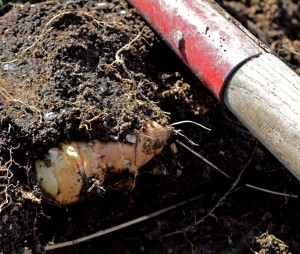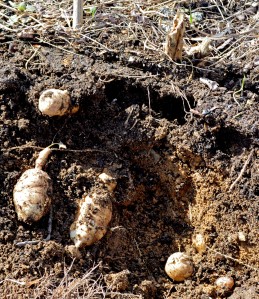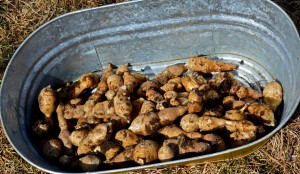It is hard to believe that this time of year, after the ground has frozen and re-frozen for months, and was smothered with snow for most of winter, that there would be anything left that would qualify as food.
And yet, during the spring-like weather last week, I dug up my Jerusalem Artichoke patch. Not because I really needed it for food, but because I wanted to be reminded of the true nature of soil: that alive, crumbly substance that is womb to most of our real food. And, because I had promised a friend that I would dig up some of the tubers for her so she could start her own wild food production.
You wouldn’t think that under these dried up stalks, there’d be anything left to harvest.
These particular stalks were about 6 feet tall but they can grow to 8 or 10 feet in rich garden soil, once the tubers are more mature. In August, each hairy stalk with rough, dark green leaves produces a multitude of small sunflower blooms. In fact, Jerusalem Artichoke (Helianthus tuberosis) IS a native sunflower and was a welcome winter food for Native Americans. It does not produce those edible sunflower seeds we are all familiar with. Also, it is not an artichoke and has nothing to do with Jerusalem.
After the above-ground part of the plant dies back, the tubers inside the ground (I hate to say “under” the ground because what’s under the ground is subsoil and then rock layers). The tubers are often compared to potatoes but, really, they remind me more of ginger root, the way they grow in bulbous segments, sometimes round, sometimes more elongated. Even the color is very similar to ginger root, that beige color of the paper-like skin. But the similarities stop there.
The tubers can sometimes be found just under the surface (as above). At other times, you can dig between one and two feet deep and still find some deep inside the ground.
Jerusalem Artichokes (sometimes called sunchokes) have a mild taste, like potatoes. They can be boiled and smothered in butter or sliced or grated raw into salads. A friend pickles them and gave me a little jar once as a Christmas gift – a rare delicacy.
A small patch yields a substantial amount of food. This container was filled to the top when I was finished collecting all the tubers:
Now they are sitting in my basement, drying, and then I’ll keep them in the fridge until I feel like eating them. I love collecting food that hardly took any work to grow (toss the tubers in the ground in early spring, then wait for them to grow). I love collecting food in the middle of winter when everything seems dead (I feel connected to the ancestors of this land who knew how to survive before grocery stores were in vogue). I love getting my hands inside the soil (a layer of it was still a bit frozen), in anticipation of spring and the new seeds that will be sprouting from it, producing exuberant seedlings that only want one thing: to root themselves in the soil and sprout as tall and as wide as their genetic blueprint will encourage them to do. More and more, we are learning that the soil is the key; specifically, the microbes inside the soil. The more I learn about soil, the more I am in awe of the mysteries the soil holds inside.
For more posts about what’s “Inside”, check out the WordPress Weekly Photo Challenge





Beautiful and Deep:)
LikeLike
Thank you, A.
LikeLike
Lovely and descriptive…you had me at “smothered in butter or sliced or grated raw into salads”. My mouth is watering. Gracias!
LikeLike
There are lots of tropical roots and tubers that probably are just as mouth-watering: cassava, tania root, yams….I love all of those as well 🙂
LikeLike
Thinking I may need to buy me some Name. Tastes a little like sweet potato.
LikeLike
Name? Never heard of it, but do smother it with lots of butter 🙂
LikeLike
OMG, I LOVE Jerusalem Artichokes. Eat them whenever they’re available around here, which isn’t often. Lucky you to grow them!
LikeLike
According to my Peterson Edible Wild Plants book, they grow down into Georgia. So next time you pick some up at the store, put some in the ground (preferably now, early spring). But be warned: they will spread and you won’t be able to get rid of them. It’s a forever food source 🙂 Good eatin’….
LikeLike
Pingback: What’s Going On | THE MARRIED MAN WHO LOVES HIS X
Thanks – i learned a lot in this one and your writing – hey are you a journalist? Lou says he doesn’t like these, and I’ve never tasted them. We are going to put some in the ground anyway, now that I’ve read this.
LikeLike
Aggie, even if you never eat them, they are a beautiful sight when in bloom. Plus they are native plants and we want to spread those around…..a friend is planning to put them into a hill side to control erosion (I hope that works).
LikeLike
Thank you for the added info. Do please share a photo when they bloom this year.
LikeLike
I will add a picture when I get my regular computer back from the repair shop – hopefully, this will be soon 🙂
LikeLike
Oh, yes, I will add my prayer to yours.
LikeLike
And I have the opposite reaction! Just cannot eat/digest them, usually OK unless they are the main dish at a dinner party!
LikeLike
I’ve never tried Jeruslaem Artichokes, but I’m sure I’ve seen them in the market here. I tend not to buy things that I don’t know how to cook. 🙂
LikeLike
If you like potatoes, you’ll probably like J.A. – they have a very mild taste AND they cook very quickly. Or you just peel them and grate them raw, a really nice crispy addition to a salad. And their glycemic level is lower than that of potatoes…. be adventurous 🙂
LikeLike
Live dangerously. 😀 Thanks for the cooking tips. 🙂
LikeLike
My kind of girl….
LikeLike
Pingback: Weekly Photo Challenge; Inside | NOE Style
Pingback: Cracking up | Words 'n Pics...
Pingback: Weekly Photo Challenge – Inside – Peek a boo. |
I haven’t thought of Jerusalem Artichokes for ages. We used to harvest them all the time. I wonder if they will grow in Nicaragua? I think I’ll try to find a tuber and sneak it back to Nica in my suitcase. Thanks for the memories and the detailed description. 🙂 They are delicious.
LikeLike
Don’t let customs catch you 🙂 I don’t know whether it would grow in a tropical climate, you might be better off growing some tubers more suited to the climate. Cassava, yam, taro….there are so many wonderful tropical tubers and roots. Because the sunchokes are so hardy in frozen soil, I am wondering whether they need a certain period of very cold temps to thrive….But if you are successful, I wonna know….:-)
LikeLike
Tropical gardening is always such a mystery! Two years ago a friend smuggled a sweet potato in her suitcase. They grow here like a wild fire. Ron is the sweet potato king of the island. lol You are probably right. I’ll bet they need cold temps to thrive. But, then again, it may be worth a try! 🙂
LikeLike
Gardening is an adventure,…can you grow regular sunflowers there?
LikeLike
What a fantastic find so early in the season. I also love gardening, but I haven’t tried growing anything like this or potatoes, or garlic.
LikeLike
Hi Shane – yes, it is very rewarding to dig them up so early in the season. The only harvesting that’s going on even earlier this year is Maple Syrup!
LikeLike
Ooh, I love the maple syrup thing. I haven’t seen that done since I was a kid and we took a class trip to an area that did it. Great stuff!
LikeLike
I am working on a post about maple sugar production…coming soon 🙂
LikeLike
I can’t wait!
LikeLike
That’s an interesting take on this photo challenge, very different!
LikeLike
Thanks, Milka, I always try to give my posts an interesting twist, if I can 🙂
LikeLike
Pingback: Inside The American Dream | this man's journey
Reblogged this on Emerald Mountain Sanctuary and commented:
You can still forage for food, even in the middle of winter!
LikeLike